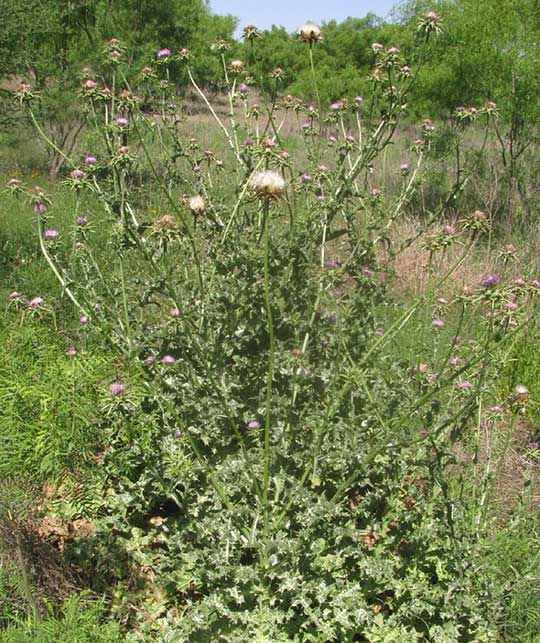Excerpts from Jim Conrad's
Naturalist Newsletter

from the May 4, 2014 Newsletter issued from the Frio Canyon Nature Education Center in the valley of the Dry Frio River in northern Uvalde County, southwestern Texas, on the southern border of the Edwards Plateau; elevation ~1750m (~5750 ft); N29.62°, W99.86°; USA
MILK THISTLE
Among the ponds and Mesquite-dominated scrub in Cooks Slough Nature Park on Uvalde's south side, one of the largest, most robustly branching thistles I've ever seen stood about six feet high (2m) beside a trail. It's shown below:

Here in cow country we have lots of thistles, since cattle eat most everything else, leaving the thistles standing and reproducing. Though some folks call almost any spiny herb a thistle, the name thistle is more conservatively reserved for species in the Composite or Sunflower Family subgroup, or "tribe," the Cynareae. Within the Cynareae, the best known genera are Carduus and Cirsium.
However, our Cooks Slough thistle isn't one of those, though it is a member of the tribe Cynareae. If you look closely at our slough plant, you see features you may not expect of a typical thistle. For example, the plant's spiny-margined leaves are up to two feet long (60cm) and, even more unusual, they're handsomely mottled, or variegated, as shown below:
 .
.
The flowering heads also are unusual because the leafy scales, or phyllaries, forming the green, bowl-like involucre below the many violet-colored florets bear spines much larger and more threatening than is seen on normal thistles, as is shown at the top of this page.
Our slough thistle has been flowering for some time, so already its old heads are opening to release parachute-equipped fruits into the wind, shown below:

We'll see below why it's worthwhile to pay special attention to the seed-like, cypsela-type fruits. A close-up of a cypsela with its parachute of white hairs is shown below:

With so many striking and unusual features, it's easy to identify this thistle as what in North America most often is called the Milk Thistle. It's SILYBUM MARIANUM, originally from the Mediterranean region of southern Europe, but now invading disturbed land throughout much of the world, including spottily throughout most of the US, but mostly in the warmer states. Though the Milk Thistle has a long history of providing food and medicine, and many regard it as pretty enough to plant as an ornamental, in Texas most folks think of it as a noxious weed -- less because of its spininess than because it causes nitrate poisoning in cattle and sheep who eat it.
In Europe during the 1500s it was well regarded as an edible herb, its young shoots being boiled and eaten like cabbage and its young leaves added to salads. In the past, even the big, spiny phyllaries surrounding the base of its flowering heads were boiled and eaten like artichoke bracts. Its stems were peeled, soaked overnight to remove the bitterness, and stewed. Its seeds were roasted, ground and used as a coffee substitute.
It's the seeds receiving most attention nowadays, because in the field of herbal medicine extracts from the seeds are much used, mostly for liver and gallbladder ailments but also to cure a wide range of problems, from hepatitis to tumors, and obsessive-compulsive disorder. Just Google the keywords "Silybum medicinal" for links to hundreds of sites praising the Milk Thistle's virtues, and selling medicines based on it.